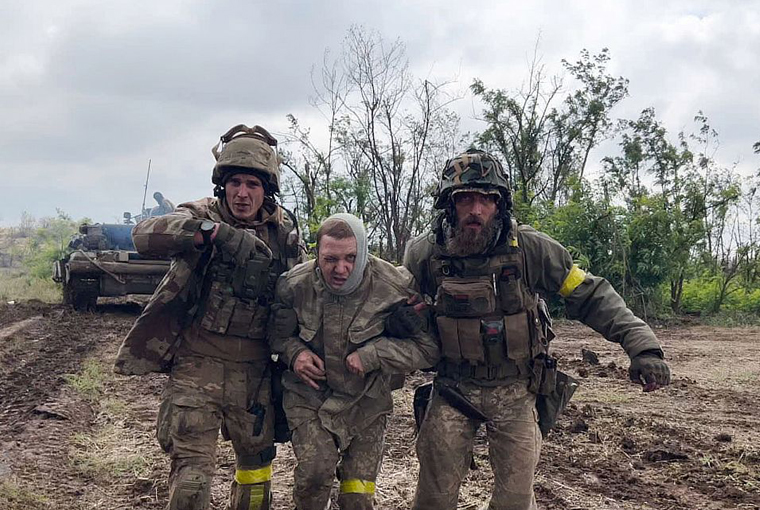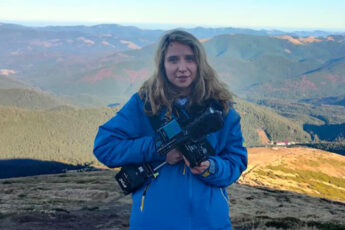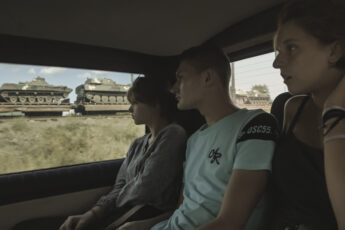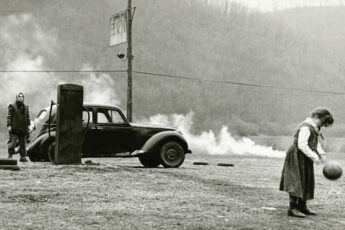The Horrors of War
Vitaly Mansky and Yevhen Titarenko’s Eastern Front (Shidniy front, 2023)
Vol. 133 (March 2023) by Jack Page
Eastern Front is an unflinching report of Russia’s invasion of Ukraine. Shooting footage from the front lines, paramedic and co-director Yevhen Titarenko is the main protagonist of the documentary. A volunteer since 2014, Titarenko’s first-hand account of the horrors of war are captured through the lens of a body camera. It is a truly up-close and personal point of view, unshrinking in its portrayal of gritty, gory details and real-life tragic episodes encountered by his medical battalion on duty. Eastern Front is a perturbing feature and one that uses the harshness of its reality to expose the truth of daily life for Ukrainian citizens who have been uprooted, oppressed, injured, and killed by Russia’s invasion of their country.
The recordings begin in Kyiv on 24 August 2022, Ukrainian’s Independence Day. A voiceover narration of a diary entry contextualizes the scene is exactly six months since Russia attacked Ukraine. The audio is of the film’s other co-director, celebrated filmmaker Vitaly Mansky. A blackened, burnt-out tank smolders behind Titarenko, an impressive introductory image of the war-torn city, but one that will become normalized as the film progresses. Driving through the unrecognizable streets, a dashboard camera frames the city’s makeshift barricades of overturned cars, disused furniture, and cement barriers in an apocalyptic light. These displays of carnage are shot with an anemic aesthetic, preserving the desolate landscape that has been ravaged by air strikes. The sheer brutality of the attacks has left Kyiv deserted, a feeling of emptiness that is matched by the images of uninhabited high-rises and apartment blocks, hollowed out and toppling down as a result of carpet bombing. Off-screen, a constant sound of gunfire, explosions, and radio chatter. For Titarenko and his team, this is the new normal of their everyday routine.
Both filmmakers direct Eastern Front with a politically charged urgency. Rejecting the role of pacifist, Titarenko’s presence is fully immersed into the documentary, leading the audience with him into the battles to reclaim territories, save as many soldiers and evacuate as many civilians as he can. In a rare moment of calm during his time in Western Ukraine, the men discuss the importance of Kharkiv. Harboring one of the largest Russian populations in the country, the group recount the preceding eight years of rampant propaganda present there and how the media held such a strong influence over an older generation. Broadcast news programs led people to believe Russia’s intervention was a blessing, villainizing Ukrainian nationalists. One soldier asks, “I don’t know what motivates the people who believe this”, to which his friend explains the public’s resolute trust of televised information. By causing civil unrest and uncertainty via popular channels of communication, a biased depiction of Russia could falsely proclaim to Ukrainians that they “have come to free you” and that their support would be undeterred. Mansky and Titarenko believe the Russian-Ukraine war actually began in 2014 with the annexation of Crimea by the Russian federation, though it was not until 24 February 2022 that the war was escalated globally. The filmmakers chose the documentary form of expression because the medium of TV and news reporting was too fallible and had the potential to be unfaithful to their message.
Split between catastrophic sequences of urban warzones and scenes of pastoral bliss, Eastern Front shares its focal point of frontline action and Titarenko’s personal journey in equal measure. In a small farming village of Western Ukraine, the Soupchik family provide lodging and food for on duty soldiers and their kin. Intimate and idyllic settings of picnics and christenings depict a group of people determined to continue their lives unafraid. The dinner table is a safe space where the locals share memories, discuss starting families and toast to the attendees’ health. These ceremonies and celebrations are seldom interrupted by political speech. Instead, their defiance is shown in the way they simply try to carry on as usual. Not only do these instances humanize the soldiers, they offer the spectator a temporary escape from the gruesome violence throughout the film.
The visceral horrors of war are never too far from the Soupchiks’ front doorstep. After their pleasant meals, in the break of dawn, the men kiss their wives and babies farewell. Their rituals of goodbye with the neighbors is an important one, as it could also be their last. There are a number of striking set pieces in Eastern Front that reveal the sheer levels of brutality and bloodshed that Titarenko confronts on a daily basis. A critically wounded man is taxied in an ambulance to the emergency hospital. In real-time, his body grows paler with the loss of blood. As his lifeforce slowly escapes his body, a death rattle emanates from his throat. The point of view of the body camera aligns the spectator with the role of the medic as the resuscitation process begins. Racing against the clock, it’s a harrowing ordeal that exemplifies the futility of some of their missions. Similarly, when traveling through farmland, the battalion pass hundreds of dying cattle. Abandoned from recent shelling, the conditions in which the cows are kept has become unlivable. Without maintenance, the animals are left to starve, drowning in a muddy swamp. The soldiers attempt to rescue the cattle by spooking them to life with gunshots or lifting them out of the dirt with rope. But the strength of the exhausted cows is waning and the audience quickly come to the realization that the animals will slowly and painfully perish.
As the screen dissolves into a bright white background, Titarenko’s labored breathing can still be heard over the end credits of Eastern Front. It is a boldly symbolic technique that suggests, unlike the film, the war in Ukraine continues. The lingering sound of his protracted physical exertion is a keen reminder of his arduous and courageous occupation and a key indicator that the fighting is far from over.




Leave a Comment